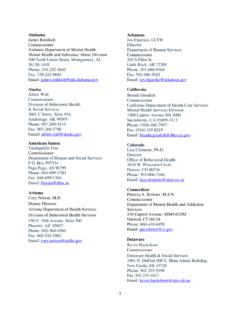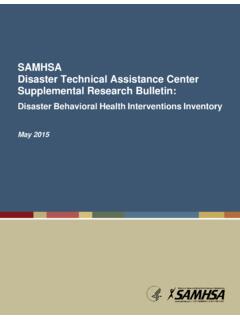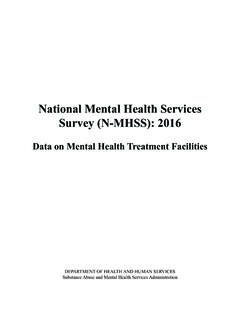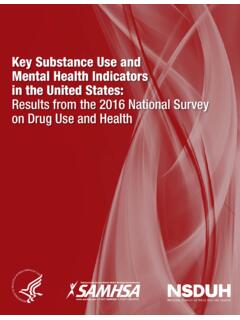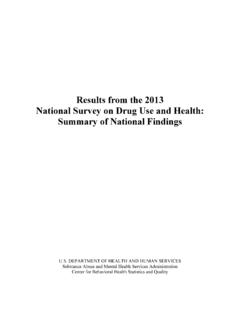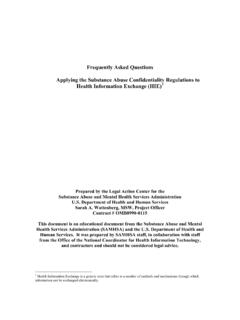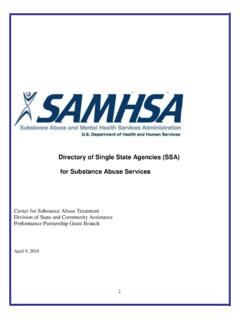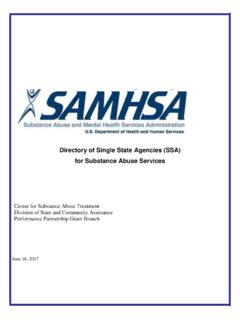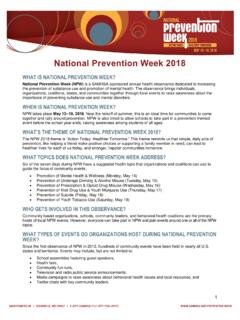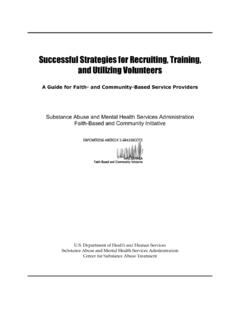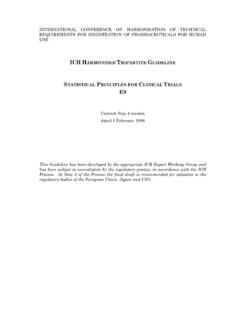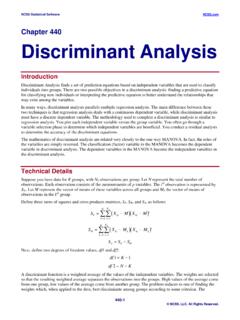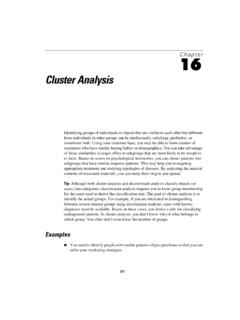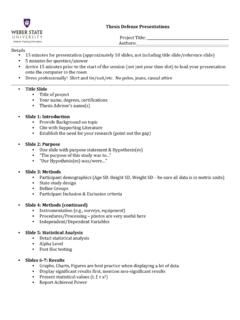Transcription of Standards and Guidelines for Statistical Surveys
1 OFFICE OF MANAGEMENT AND BUDGET Standards AND Guidelines FOR Statistical Surveys September 2006 Table of Contents LIST OF Standards FOR Statistical i 1 SECTION 1 DEVELOPMENT OF CONCEPTS, METHODS, AND 5 Section survey 5 Section survey 7 Section survey Response 8 Section Pretesting survey 9 SECTION 2 COLLECTION OF 9 Section Developing Sampling 9 Section Required Notifications to Potential survey 10 Section Data Collection 11 SECTION 3 PROCESSING AND EDITING OF 13 Section Data 13 Section Nonresponse Analysis and Response Rate 14 Section 17 Section Data 18 Section 19 SECTION 4 PRODUCTION OF ESTIMATES AND 20 Section Developing Estimates and 20 SECTION 5 DATA 21 Section Analysis and Report 21 Section Inference and 22 SECTION 6 REVIEW 23 Section Review of Information 23 SECTION 7 DISSEMINATION OF INFORMATION 24 Section Releasing 24 Section Data
2 Protection and Disclosure Avoidance for 25 Section survey 26 Section Documentation and Release of Public-Use 27 APPENDIX DEFINITIONS OF KEY 29 LIST OF Standards FOR Statistical Surveys SECTION 1 DEVELOPMENT OF CONCEPTS, METHODS, AND DESIGN survey Planning Standard : Agencies initiating a new survey or major revision of an existing survey must develop a written plan that sets forth a justification, including: goals and objectives; potential users; the decisions the survey is designed to inform; key survey estimates; the precision required of the estimates ( , the size of differences that need to be detected); the tabulations and analytic results that will inform decisions and other uses; related and previous Surveys ; steps taken to prevent unnecessary duplication with other sources of information; when and how frequently users need the data; and the level of detail needed in tabulations, confidential microdata, and public-use data files.
3 survey Design Standard : Agencies must develop a survey design, including defining the target population, designing the sampling plan, specifying the data collection instrument and methods, developing a realistic timetable and cost estimate, and selecting samples using generally accepted Statistical methods ( , probabilistic methods that can provide estimates of sampling error). Any use of nonprobability sampling methods ( , cut-off or model-based samples) must be justified statistically and be able to measure estimation error. The size and design of the sample must reflect the level of detail needed in tabulations and other data products, and the precision required of key estimates. Documentation of each of these activities and resulting decisions must be maintained in the project files for use in documentation (see Standards and ).
4 survey Response Rates Standard : Agencies must design the survey to achieve the highest practical rates of response, commensurate with the importance of survey uses, respondent burden, and data collection costs, to ensure that survey results are representative of the target population so that they can be used with confidence to inform decisions. Nonresponse bias analyses must be conducted when unit or item response rates or other factors suggest the potential for bias to occur. Pretesting survey Systems Standard : Agencies must ensure that all components of a survey function as intended when implemented in the full-scale survey and that measurement error is controlled by conducting a pretest of the survey components or by having successfully fielded the survey components on a previous occasion.
5 SECTION 2 COLLECTION OF DATA Developing Sampling Frames Standard : Agencies must ensure that the frames for the planned sample survey or census are appropriate for the study design and are evaluated against the target population for quality. i Required Notifications to Potential survey Respondents Standard : Agencies must ensure that each collection of information instrument clearly states the reasons the information is planned to be collected; the way such information is planned to be used to further the proper performance of the functions of the agency; whether responses to the collection of information are voluntary or mandatory (citing authority); the nature and extent of confidentiality to be provided, if any, citing authority; an estimate of the average respondent burden together with a request that the public direct to the agency any comments concerning the accuracy of this burden estimate and any suggestions for reducing this burden; the OMB control number.
6 And a statement that an agency may not conduct and a person is not required to respond to an information collection request unless it displays a currently valid OMB control number. Data Collection Methodology Standard : Agencies must design and administer their data collection instruments and methods in a manner that achieves the best balance between maximizing data quality and controlling measurement error while minimizing respondent burden and cost. SECTION 3 PROCESSING AND EDITING OF DATA Data Editing Standard : Agencies must edit data appropriately, based on available information, to mitigate or correct detectable errors. Nonresponse Analysis and Response Rate Calculation Standard : Agencies must appropriately measure, adjust for, report, and analyze unit and item nonresponse to assess their effects on data quality and to inform users.
7 Response rates must be computed using standard formulas to measure the proportion of the eligible sample that is represented by the responding units in each study, as an indicator of potential nonresponse bias. Coding Standard : Agencies must add codes to collected data to identify aspects of data quality from the collection ( , missing data) in order to allow users to appropriately analyze the data. Codes added to convert information collected as text into a form that permits immediate analysis must use standardized codes, when available, to enhance comparability. Data Protection Standard : Agencies must implement safeguards throughout the production process to ensure that survey data are handled to avoid disclosure. Evaluation Standard : Agencies must evaluate the quality of the data and make the evaluation public (through technical notes and documentation included in reports of results or through a separate report) to allow users to interpret results of analyses, and to help designers of recurring Surveys focus improvement efforts.
8 IiSECTION 4 PRODUCTION OF ESTIMATES AND PROJECTIONS Developing Estimates and Projections Standard : Agencies must use accepted theory and methods when deriving direct survey -based estimates, as well as model-based estimates and projections that use survey data. Error estimates must be calculated and disseminated to support assessment of the appropriateness of the uses of the estimates or projections. Agencies must plan and implement evaluations to assess the quality of the estimates and projections. SECTION 5 DATA ANALYSIS Analysis and Report Planning Standard : Agencies must develop a plan for the analysis of survey data prior to the start of a specific analysis to ensure that Statistical tests are used appropriately and that adequate resources are available to complete the analysis.
9 Inference and Comparisons Standard : Agencies must base statements of comparisons and other Statistical conclusions derived from survey data on acceptable Statistical practice. SECTION 6 REVIEW procedures Review of Information Products Standard : Agencies are responsible for the quality of information that they disseminate and must institute appropriate content/subject matter, Statistical , and methodological review procedures to comply with OMB and agency Information Quality Guidelines . SECTION 7 DISSEMINATION OF INFORMATION PRODUCTS Releasing Information Standard : Agencies must release information intended for the general public according to a dissemination plan that provides for equivalent, timely access to all users and provides information to the public about the agencies dissemination policies and procedures including those related to any planned or unanticipated data revisions.
10 Data Protection and Disclosure Avoidance for Dissemination Standard : When releasing information products, agencies must ensure strict compliance with any confidentiality pledge to the respondents and all applicable Federal legislation and regulations. survey Documentation Standard : Agencies must produce survey documentation that includes those materials necessary to understand how to properly analyze data from each survey , as well as the information necessary to replicate and evaluate each survey s results (See also Standard ). survey documentation must be readily accessible to users, unless it is necessary to restrict access to protect confidentiality. iiiDocumentation and Release of Public-Use Microdata Standard : Agencies that release microdata to the public must include documentation clearly describing how the information is constructed and provide the metadata necessary for users to access and manipulate the data (See also Standard ).
